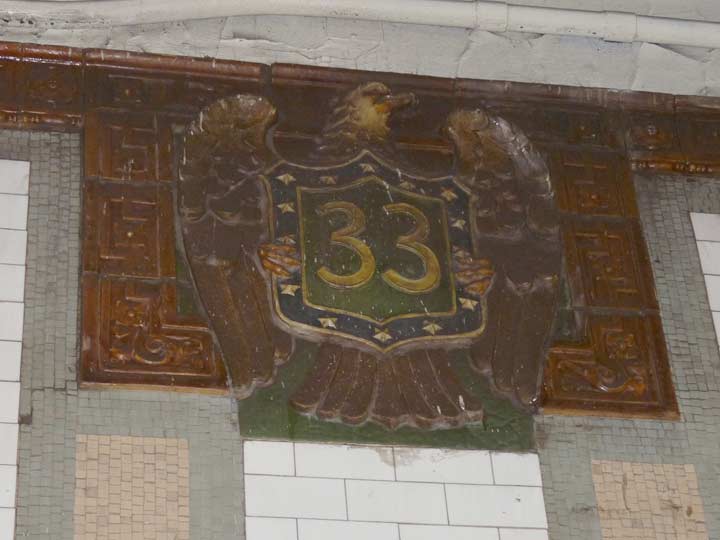
The IRT 33rd Street station, one of the original 28 stations on the Interborough Rapid Transit, or IRT, was built at the former site of the 71st Regiment Armory, which was completed a year after the subway arrived in 1904. This was actually the second armory on the site: an earlier one built in 1892 burned down 10 years later. The site is now occupied by the 42-story 3 Park Avenue building.
It’s been said that faience and mosaic eagles in stations indicate that armories were located above the stations, but that’s only true here at 33rd Street. At Brooklyn Bridge and 14th Street, no such armories existed, and yet, eagle plaques were produced for those stations as well. The remaining Brooklyn Bridge eagles are maintained in an area not open to the public, while the 14th Street ceramic eagles have been placed as an exhibit in a mezzanine connecting the BMT and IRT. Only 33rd Street displays the eagles in situ, or in their original positions.
Notice the swastika pattern on the faience plaque. It’s innocent in origin: the German National Socialist Party wouldn’t adopt it as a symbol until the 1920s, and before that, it was simply a symbol of good fortune. In fact it may be here as a consequence of the artwork pattern and isn’t intentionally a swastika pattern at all.

In a couple of circumstances not shown here, mosaic eagles stand in for the ceramics. Those eagles were added in 1925 when the station was reconfigured and Park Avenue was widened. In this photo, also note the Beaux Arts ornamentation found on the station ceiling. In some cases you can still see the original stanchions that held the incandescent bulbs that used to light the stations (fluorescent tubing wasn’t introduced in the subways until the Fab Fifties, and well into the 1980s, bare incandescent bulbs still lit a number of stations).
One puzzler for me is the inclusion of 14 stars on the shield, instead of the usual 13, for the 13 original states. Perhaps the designer felt that 13 stars could not be distributed evenly, though other designs I’ve seen are up to that challenge.
7/21/15

1 comment
As long as the product is not a replica of he Great Seal of the US, more than 13 stars is OK…plenty of US currency have stars that don’t coincide with numbers of states. So, it appears the artist went for symmetry as you noted. This site is fantastic, BTW.